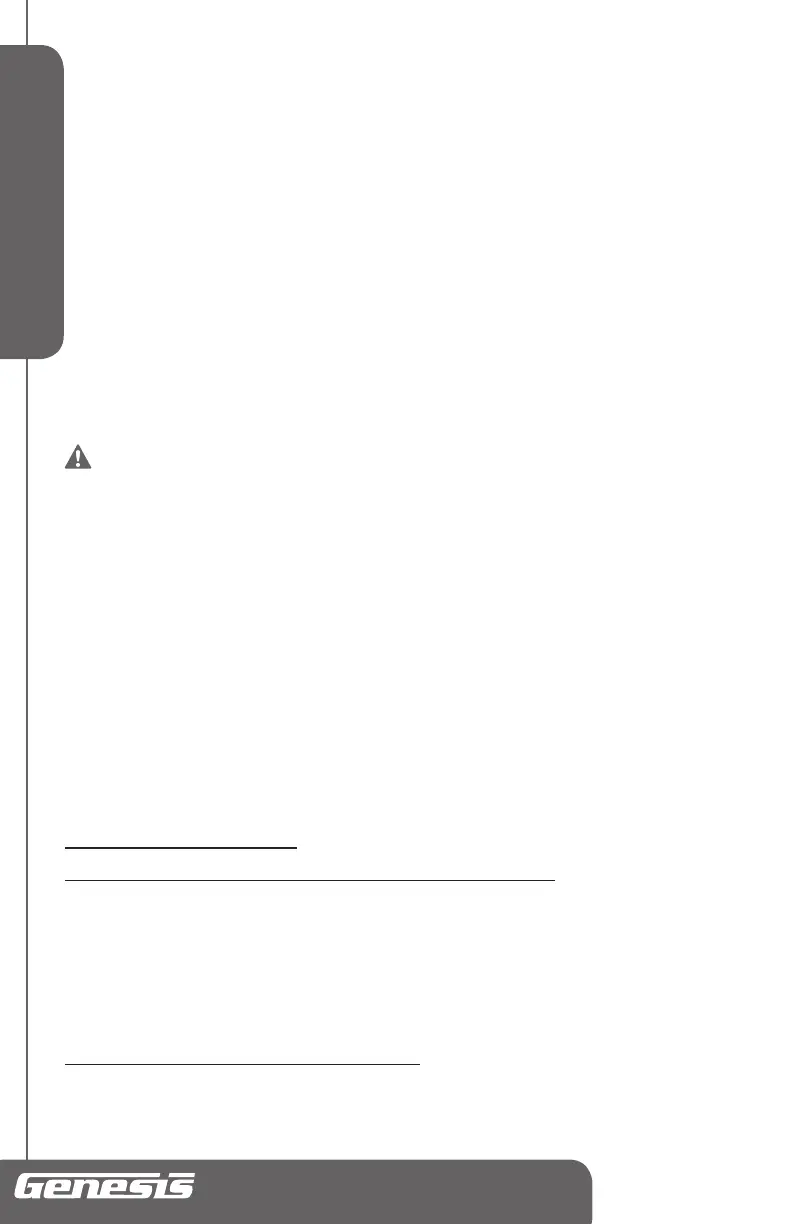English
1/2" Spade-Handle Electric Drill
Operator’s Manual GSHD1290
• Turn power tool off, and disconnect the plug from the power source and/or battery pack
from the power tool before making any adjustments, changing the accessories, or storing the tools. Such
preventive safety measures reduce the risk of an accidental start up which may cause personal injury.
•
Store idle tool out of reach of children and other inexperienced persons. It is
dangerous in the hand of untrained users.
•
Maintain power tools with care. Check for proper alignment and binding of moving parts,
component breaks, and any other conditions that may affect the tool’s operation. A guard or any other part that
is damaged must be properly repaired or replaced by an authorized service center to avoid risk of personal
injury.
•
Use recommended accessories. Using accessories and attachments not recommended by the
manufacturer or intended for use on this type tool may cause damage to the tool or result in personal injury to
the user. Consult the operator’s manual for recommended accessories.
•
Keep cutting tools sharp and clean. Properly maintained cutting tools with sharp cutting edges
are less likely to bind and are easier to control.
•
Feed the workpiece in the correct direction and speed. Feed the workpiece into a
blade, cutter, or abrasive surface against the direction of the cutting tool’s direction of rotation only. Incorrectly
feeding the workpiece in the same direction may cause the workpiece to be thrown out at high speed.
•
Never leave the tool running unattended, turn the power off. Do not leave the tool
until it comes to a complete stop.
WARNING: USE OF THIS TOOL CAN GENERATE AND DISBURSE DUST OR
OTHER AIRBORNE PARTICLES, INCLUDING WOOD DUST, CRYSTALLINE SILICA DUST
AND ASBESTOS. Direct particles away from face and body. Always operate tool in a well-
ventilated area and provide for proper dust removal. Use dust collection system wherever
possible. Exposure to the dust may cause serious and permanent respiratory or other
injury, including silicosis (a serious lung disease), cancer, and death. Avoid breathing the
dust, and avoid prolonged contact with the dust. Allowing dust to get into your mouth or
eyes, or lay on your skin may promote absorption of harmful material. Always use properly
fitting NIOSH/OSHA approved respiratory protection appropriate for dust exposure, and
wash exposed areas with soap and water.
SERVICE
• Have your power tool serviced by a qualified repair person using
only identical
replacement parts. This will ensure that the safety of the power tool is maintained.
•
Service your power tool periodically. When cleaning a tool, be careful not to disassemble any
portion of the tool since internal wires may be misplaced or pinched.
SAVE THESE INSTRUCTIONS
EXTENSION CORDS
Grounded tools require a three wire extension cord. Double insulated tools can use
either a two or three wire extension cord. As the distance from the power supply outlet increases, you must use a
heavier gauge extension cord. Using extension cords with inadequately sized wire causes a serious drop in voltage,
resulting in loss of power and possible tool damage. Refer to the table shown below to determine the required
minimum wire size.
The smaller the gauge number of the wire, the greater the capacity of the cord. For example: a 14-gauge cord
can carry a higher current than a 16-gauge cord. When using more than one extension cord to make up the total
length, be sure each cord contains at least the minimum wire size required. If you are using one extension cord for
more than one tool, add the nameplate amperes and use the sum to determine the required minimum wire size.
Guidelines for Using Extension Cords
• If you are using an extension cord outdoors, be sure it is marked with the suffix “W-A” (“W” in Canada) to indicate
that it is acceptable for outdoor use.

